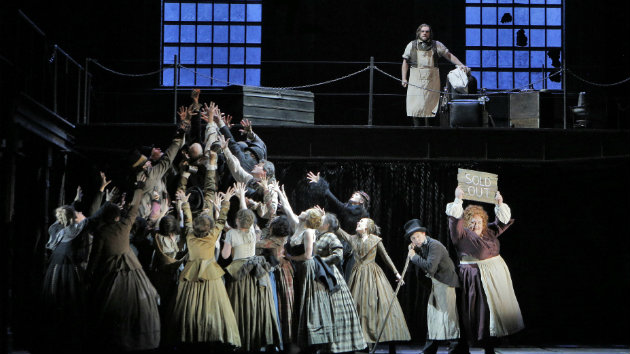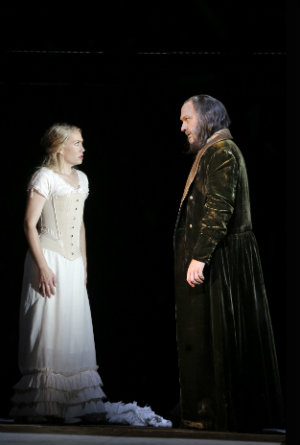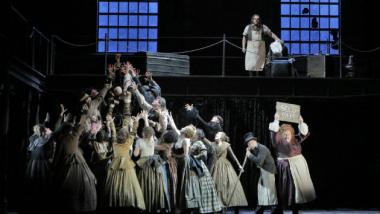
Like any music drama masterpiece, Sweeney Todd: The Demon Barber of Fleet Street can appear in multiple guises and near disguises and still deliver its indelible, irreducible essence.
Stephen Sondheim's “musical thriller,” which first opened in Harold Prince’s heroically scaled staging on Broadway in 1979, has been jiggered around in time and context, performed in concert versions, made into a film starring Johnny Depp and Helena Bonham Carter, semi-tamed for high school productions and razored down to a chamber version in which 10 actors not only performed all the parts but the orchestra score as well. Anyone who saw it is unlikely to forget Patti LuPone’s Mrs. Lovett barging around a compact stage tooting a tuba.
Sweeney has also been mounted in opera houses, an enterprise pioneered 31 years ago by San Francisco Opera General Director David Gockley, when he presented the work at the Houston Grand Opera. Now, in a long cherished ambition realized late in his San Francisco tenure, Gockley has given opera patrons here a fresh helping of Sondheim’s grim, gorgeous, and haunting Grand Guignol. The production opened September 12 and runs through September 29 at the War Memorial Opera House.
The question of whether Sweeney is a musical or an opera is, finally, an unenlightening one. Frightening and funny, intense and drolly detached, ravishing and bleak, it carves out its own dramatic turf in telling the tale of a revenge-maddened barber who returns to London after a long banishment to slaughter a string of victims and conspire with a local baker to serve their flesh in meat pies to a ravenous public.
It would take a team of psychiatrists and philosophers to unpack what this amazing show has to say about love, venality, vengeance, morality, and madness. What finally matters most is how Sweeney embeds all that in Sondheim’s masterly music and perhaps even more brilliant lyrics and how that fusion works its wonders on a live audience.
There’s no simple verdict about the San Francisco Opera production. Driven by powerful musical moments and several standout performances, this Sweeney Todd rides on strong pulse beats that carry the audience through some rather studied and static passages. Director Lee Blakely’s staging looks suitably grim on a two-level factory-look set reminiscent of the enormous bridge design from the original Broadway production. His single greatest inspiration, the complex interweaving of an asylum chorus into the second act, also results in some posing and other forms of theatrical murkiness.

In casting for operatic voices, led by baritone Brian Mulligan in the title role and mezzo-soprano Stephanie Blythe as his culinary accomplice, Mrs. Lovett, and then using Broadway-ish amplification to mike the principals and some areas of the stage, this Sweeney straddles two realms. The sound system was still a work-in-progress on opening night, with erratic levels and a few noisy technical glitches as well. Maybe the board operator was spooked by all the merrily spurting blood and summarily dumped bodies.
Blythe crossed the opera/Broadway divide in glorious form, with a performance that joined vocal grandeur to a grounded earthiness and blunt, insouciant self-knowledge. She’s herself through and through, pragmatic and blithe (pun intended, risky as it is to play any word games in Sondheim’s presence). In the famous first act closer, the cannibalistic waltz tune “A Little Priest,” Blythe and Mulligan capered through a comic catalogue of human taste sensations with ebullient timing. Blythe was even better in “By the Sea,” with her fluting “hoo-hoos” and daintily bawdy winks and faux-innocence.
Mulligan played and sang Sweeney with a kind of imploded rage, his face and form locked in with determination. Blythe had to work hard to get a reaction from him, and rarely succeeded. In this “relationship,” she did all the heavy lifting. Mulligan’s voice had a steely rawness that warmed up to a sinister seductiveness in “Pretty Women,” when he was toying with a hated rival. He made the audience see and hear the acid eating away at Sweeney, but left some of the character’s mounting furies and black comic potential under-explored. "[Stephanie] Blythe crossed the opera/Broadway divide in glorious form, with a performance that joined vocal grandeur to a grounded earthiness and blunt, insouciant self-knowledge.”
Tenor Matthew Grills, as Tobias, an innocent boy who’s wising up to the Sweeney-Lovett scheme, gave a glowingly tender account of “Nothing’s Going To Harm You,” with Blythe partnering him expertly. Baritone Elliot Madore was a lively and eager if somewhat vocally bland Anthony Hope, the sailor who is courting pretty young Johanna. Heidi Stober sang the ingenue role in a light and suitably frantic soprano and played her brief mad scene with fevered emotion.
It was a nice touch, in Blakeley’s production, to make it clear the two have been to bed together. Sex, like violence, comes bubbling to the surface in dangerous ways. Bass-baritone Wayne Tigges, as the predatory Judge Turpin, made that explicit with his lascivious diction and delivery and a bare-chested bout of erotic self-flagellation.
A different sort of energy ran through the Opera House for the Sweeney opener. It was clear, from some of the startled reactions, that a fair portion of the audience was new to the piece. They responded with a full-throated ovation at the end. Mission accomplished and then some: San Francisco Opera swung open the doors, some squeaky hinges notwithstanding, on a great work that marries inspired words and music, ideas and emotion, violence and sex, tragedy and comedy, terror and transcendence.
Sounds like what a night at the opera ought to be.

